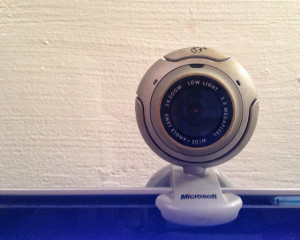Dr. David Neville utilizes YouTube to educate beyond the classroom
 A number of faculty members on campus are turning to videos to supplement their courses, and Dr. David Neville of the German department is no exception. With a background in education and instructional technology, Dr. Neville always had a desire to utilize video in his courses, but with the help of YouTube, the impact of video recording has been more widespread than he ever imagined.
A number of faculty members on campus are turning to videos to supplement their courses, and Dr. David Neville of the German department is no exception. With a background in education and instructional technology, Dr. Neville always had a desire to utilize video in his courses, but with the help of YouTube, the impact of video recording has been more widespread than he ever imagined.
Videos for the classroom
Dr. Neville’s experiences with screencasting—the digitally recording of a computer screen—started at Utah State University, where he was studying for a master’s degree in instructional design and technology. In the program, they were working with learning objects, which are collections of resources to teach, practice and assess a student on a single learning objective, and how videos could help that process.
“They were doing cool stuff [with videos],” Dr. Neville said. “One thing they were doing was figuring out how to use different types of learning objects to teach, and they were using Camtasia to do that. I realized I needed to do that for my classes, and I started doing that as soon as I got [to Elon].”
Impressed with he saw, Dr. Neville immediately incorporated videos into his classes as resources for his students.
“I originally started [making videos] for all my courses, but then focused more on beginning German language courses,” Dr. Neville said. “The videos were canned lectures that presented grammar topics.”
However, Dr. Neville saw an opportunity to integrate the videos even more. Students now learn some content via short informational videos, and are then tested on what they learned in the videos.
“I made them an integral part of the class,” Dr. Neville said. “They became part of the curriculum. Students look at videos before they come to class and they complete online exercises. I can then go in and check what they do and don’t understand.”
By utilize his videos and their assessments as out-of-the-classroom activities, Dr. Neville can teach simpler content. Because of that, he has more time in class to instruct his students on the complicated material that requires careful attention.
“It means more time on doing more complex things like focusing on writing skills and conversation,” Dr. Neville said. “I’m using it as a way to free up more time in the classroom.”
MORE: Interested in screencasting? Here are some tips for creating impactful online lectures.
For his students and beyond
Dr. Neville created the videos with his students’ needs in mind, and they have not failed in the aim. In fact, Dr. Neville says that his students have very positively responded to the availability of the video content.
“I presented them as a resource students could use if they wanted to, and a lot of them did,” Dr. Neville said. “I’ve received quite a lot of good comments on evaluations. Students really like the videos and find them useful.”
But it’s not just Dr. Neville’s students who are benefitting from his videos. Dr. Neville decided to upload his videos to YouTube, which has yielded an even greater audience to his content.
“I used to have them on my Moodle site, because I was afraid to put it online where everyone can look at it,” Dr. Neville said. “But when I put them on my YouTube channel, they got a lot of hits. There’s a lot of traffic. People are really looking for it.”
One of his student mentioned that her friend from Colgate University used his videos to study. Overall, Dr. Neville believes he has benefitted from uploading his videos online for the general public.
“Most people were very thankful for the videos,” Dr. Neville said. “I do get criticism, but it’s constructive. It helps me see the different ways to think about the material. I can make it a better instructional tool.”
Take the plunge with screen recording
Dr. Neville’s use of videos has improved the way his courses function and has overall benefitted his students’ comprehension of German language and grammar. To him, creating these videos are worth the extra effort
“I do it in my office,” Dr. Neville said. “Once you make a video, you can use it in so many other contexts. Apply it one course or another course. Flip your classroom. Create a distance education course. You can use it for all sorts of different things. You develop the videos once, and deploy in other contexts.”
Though he understands the hesitation to create videos, he thinks those who are interested should jump into the process of screen recording and not to be afraid to share those videos publicly, like he did with YouTube.
“Just do it,” Dr. Neville said. “I would encourage people to put it online. You get a lot of better feedback that way and see how people interact with it. I also encourage people to keep it simple and short.”
If you are interested in learning more about screencasting or finding videos to use in your course, contact TLT to setup an appointment.
Image via Flickr user CaptMikey9 / CC BY 2.0
 Follow
Follow


Utilizing technology to further education is the wave of the future. Dr. Neville’s approach to education gives both his student and those outside of his classroom, or university, a platform for learning that can be modified and tailored to their needs. More so than the traditional textbook, the videos are equipped to aid students in their studies in our ever digitizing world. I think this is great and hope more educators follow in Dr. Neville’s innovative footsteps.